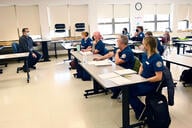You have /5 articles left.
Sign up for a free account or log in.
The market of massive open online courses is packed with prestigious universities and star professors. Then there’s SUNY Broome Community College.
The institution is part of the State University of New York System, which in turn is a member of the MOOC platform Coursera. While Coursera and edX, another major platform, have dozens of college and university system members, SUNY Broome, which is located in Binghamton, N.Y., is the only community college among them that offers a MOOC.
SUNY Broome’s sole MOOC, Foundations for Assisting in Home Care, launched in June and was offered twice last year, attracting about 1,200 learners in about 100 different countries -- modest numbers compared to larger MOOCs. Still, Francis L. Battisti, the community college’s executive vice president and chief academic officer, said the college feels the course has succeeded as a way to spread its brand, reach new students and, most importantly, serve people in central New York.
“One of the things that community colleges are all about is service to the community,” Battisti said in an interview. “Sometimes with all the competition for [full-time students], we kind of lose that focus.”
Community colleges’ involvement in the MOOC market has primarily been as consumers. The Bill & Melinda Gates Foundation has been a major force behind that work, spending millions of dollars on grants to projects that have examined if MOOCs can help students complete introductory courses. Examples include the American Council on Education’s Alternative Credit Project and MOOC provider edX’s work with community colleges in the Boston region.
Why not as producers? Fred Lokken, a member of the Instructional Technology Council’s board of directors, called it a “philosophical problem.” Community colleges stress the importance of face-to-face communication with students, he said, and the idea of enrolling thousands of students in an online course “cuts against the grain of what community colleges believe in.”
The ITC, which is affiliated with the American Association of Community Colleges, assists member institutions with online education. The organization recently eliminated a question in its annual survey of trends in distance education about MOOCs because of a lack of interest, Lokken said. In the most recent edition, 70 percent of respondents said they had no interest in using MOOCs in their courses, compared to only 3 percent who said they did. But while community colleges may not be well represented on Coursera or edX, Lokken pointed out that many offer MOOCs through their learning management systems.
Others pointed to a simpler reason: creating a MOOC can take dozens of hours and cost tens if not hundreds of thousands of dollars -- a sizable investment for any institution, let alone a community college. Shifting those kinds of resources away from other offices on campus “would have been really difficult,” Battisti said.
Instead, SUNY Broome applied for and received two SUNY Innovative Instruction Technology Grants worth about $46,000 earmarked for MOOC development. The first grant made it possible to hire a videographer and shoot a series of video lectures, while the second funded the creation of a free textbook created in partnership with SUNY Geneseo, Battisti said.
“To be perfectly honest, if we didn’t get the grants, we probably couldn’t have done it,” Battisti said. “Our budget is so limited.”
As part of the second grant, SUNY Broome is this spring working with Mohawk Valley Community College, located in Utica. Mohawk Valley will use the course materials from the MOOC in its home health care aide curriculum to test how they work in a traditional face-to-face setting, said Erin K. O’Hara-Leslie, chair of the medical assisting and health studies department at SUNY Broome.
O’Hara-Leslie described a MOOC development process that differs from how many four-year universities have approached the courses. Those MOOCs have largely attracted people with previously earned degrees looking for continuing education. Community colleges, she said, are known are places that set students on the path to educational attainment or direct employment. SUNY Broome focused on the latter when developing the MOOC, giving learners a low-risk opportunity to see if a career in home health care is right for them, she said.
The emphasis on home health care is particular important in the Southern Tier of New York, where the state Department of Labor expects it will need about 1,600 new home health and personal care aides by 2018 to keep up with demand from an aging population.
“It’s incredibly costly to train people as a home health care aide, and this way it kind of shakes people out,” O’Hara-Leslie said.
SUNY Broome currently doesn’t offer a home health care aide program but hopes to do so in the future, O’Hara-Leslie said, adding that she expects the MOOC to be a part of that program.
Since the community college is giving the textbook away for free, O’Hara-Leslie said she hopes the information will have even wider appeal, perhaps to people wondering how to prepare food for their elderly parents or move them safely in and out of bed, for example.
“It’s more of a philanthropy,” O’Hara-Leslie said. “We’re not making money off of this, but it can be utilized in school, in home health care agencies for training, and then it can also be used on a different level [by] people who aren’t sure how to care for a relative.”
SUNY Broome has had conversations about expanding its MOOC offerings, perhaps in cooperation with New York’s Regional Economic Development Councils, Battisti said. But that expansion comes with a big “if,” he said: “If there was more funding.”




